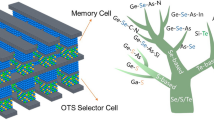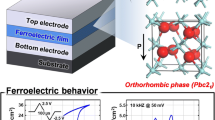Abstract
In recent years, trap-related interfacial transport phenomena have received great attention owing to their potential applications in resistive switching devices and photo detectors. Not long ago, one new type of memristive interface that is composed of F-doped SnO2 and Bi2S3 nano-network layers has demonstrated a bivariate-continuous-tunable resistance with a swift response comparable to the one in neuron synapses and with a brain-like memorizing capability. However, the resistive mechanism is still not clearly understood because of lack of evidence, and the limited improvement in the development of the interfacial device. By combining I–V characterization, electron energy-loss spectroscopy, and first-principle calculation, we studied in detail the macro/micro features of the memristive interface using experimental and theoretical methods, and confirmed that its atomic origin is attributed to the traps induced by O-doping. This implies that impurity-doping might be an effective strategy for improving switching features and building new interfacial memristors.

Similar content being viewed by others
References
Strukov, D. B.; Snider, G. S.; Stewart, D. R.; Williams, R. S. The missing memristor found. Nature 2008, 453, 80–83.
Yang, J. J.; Pickett, M. D.; Li, X. M.; Ohlberg, D. A. A.; Stewart, D. R.; Williams, R. S. Memristive switching mechanism for metal/oxide/metal nanodevices. Nat. Nanotechnol. 2008, 3, 429–433.
Jo, S. H.; Chang, T.; Ebong, I.; Bhadviya, B. B.; Mazumder, P.; Lu, W. Nanoscale memristor device as synapse in neuromorphic systems. Nano Lett. 2010, 10, 1297–1301.
Pan, F.; Gao, S.; Chen, C.; Song, C.; Zeng, F. Recent progress in resistive random access memories: Materials, switching mechanisms, and performance. Mater. Sci. Eng. R: Rep. 2014, 83, 1–59.
Lu, W.; Lieber, C. M. Nanoelectronics from the bottom up. Nat. Mater. 2007, 6, 841–850.
Tian, Y.; Guo, C. F.; Guo, S. M.; Yu, T. F.; Liu, Q. Bivariate-continuous-tunable interface memristor based on Bi2S3 nested nano-networks. Nano Res. 2014, 7, 953–962.
Tian, Y.; Zhang, J. M.; Guo, C. F.; Zhang, B. S.; Liu, Q. Photoconductive probing of the trap distribution in switchable interfaces. Nanoscale 2016, 8, 915–920.
Liu, Q.; Guan, W. H.; Long, S. B.; Jia, R.; Liu, M.; Chen, J. N. Resistive switching memory effect of ZrO2 films with Zr+ implanted. Appl. Phys. Lett. 2008, 92, 012117.
Wu, X.; Zhou, P.; Li, J.; Chen, L. Y.; Lv, H. B.; Lin, Y. Y.; Tang, T. A. Reproducible unipolar resistance switching in stoichiometric ZrO2 films. Appl. Phys. Lett. 2007, 90, 183507.
Gao, S.; Song, C.; Chen, C.; Zeng, F.; Pan, F. Dynamic processes of resistive switching in metallic filament-based organic memory devices. J. Phys. Chem. C 2012, 116, 17955–17959.
Peng, S. S.; Zhuge, F.; Chen, X. X.; Zhu, X. J.; Hu, B. L.; Pan, L.; Chen, B.; Li, R.-W. Mechanism for resistive switching in an oxide-based electrochemical metallization memory. Appl. Phys. Lett. 2012, 100, 072101.
Yu, Z. H.; Guo, L.; Du, H.; Krauss, T.; Silcox, J. Shell distribution on colloidal CdSe/ZnS quantum dots. Nano Lett. 2005, 5, 565–570.
Wang, M.; Wang, C.; Tian, Y.; Zhang, J. M.; Guo, C. F.; Zhang, X. Z.; Liu, Q. Study on optical and electric properties of ultrafine-grained indium films. Appl. Surf. Sci. 2014, 296, 209–213.
Guo, C. F.; Zhang, J. M.; Tian, Y.; Liu, Q. A general strategy to superstructured networks and nested self-similar networks of bismuth compounds. ACS Nano 2012, 6, 8746–8752.
Tian, Y.; Guo, C. F.; Guo, Y. J.; Wang, Q.; Liu, Q. BiOCl nanowire with hierarchical structure and its Raman features. Appl. Surf. Sci. 2012, 258, 1949–1954.
Tian, Y.; Guo, C. F.; Zhang, J. M.; Liu, Q. Operable persistent photoconductivity of Bi2S3 nested nano networks. Phys. Chem. Chem. Phys. 2015, 17, 851–857.
Ahire, R. R.; Sankapal, B. R.; Lokhande, C. D. Preparation and characterization of Bi2S3 thin films using modified chemical bath deposition method. Mater. Res. Bull. 2001, 36, 199–210.
Lo, C. C.; Hsieh, T. E. The influences of oxygen incorporation on the defect trap states of a-IGZO thin-film transistors. ECS Trans. 2012, 45, 239–243.
Ji, W. Y.; Jing, P. T.; Xu, W.; Yuan, X.; Wang, Y. J.; Zhao, J. L.; Jen, A. K.-Y. High color purity ZnSe/ZnS core/shell quantum dot based blue light emitting diodes with an inverted device structure. Appl. Phys. Lett. 2013, 103, 053106.
Na-Phattalung, S.; Smith, M. F.; Kim, K.; Du, M.-H.; Wei, S.-H.; Zhang, S. B.; Limpijumnong, S. First-principles study of native defects in anatase TiO2. Phys. Rev. B 2006, 73, 125205.
Xiao, H. B.; Yang, C. P.; Huang, C.; Xu, L. F.; Shi, D. W.; Marchenkov, V. V.; Medvedeva, I. V.; Bärner, K. Influence of oxygen vacancy on the electronic structure of CaCu3Ti4O12 and its deep-level vacancy trap states by first-principle calculation. J. Appl. Phys. 2012, 111, 063713.
Monthus, C. Localization properties of the anomalous diffusion phase in the directed trap model and in the Sinai diffusion with a bias. Phys. Rev. E 2003, 67, 046109.
Liu, E. K.; Zhu, B. S.; Luo, J. S. Semiconductor Physics, 6th ed.; Publishing House of Electronics Industry: Beijing, 2003.
Lampert, M. A.; Mark, P. Current Injection in Solids; Academic Press: New York, 1970.
Ge, Z.-H.; Zhang, B.-P.; Shang, P.-P.; Yu, Y.-Q.; Chen, C.; Li, J.-F. Enhancing thermoelectric properties of polycrystalline Bi2S3 by optimizing a ball-milling process. J. Electron. Mater. 2011, 40, 1087–1094.
Sun, B.; Zhao, W. X.; Liu, Y. H.; Chen, P. Resistive switching effect of Ag/MoS2/FTO device. Funct. Mater. Lett. 2015, 8, 1550010.
Acknowledgements
This research was supported by the National Key Research Program of China (No. 2016YFA0200403), National Natural Science Foundation of China (Nos. 10974037 and 11547163), the CAS Strategy Pilot program (No. XAD 09020300), Hunan Provincial Natural Science Foundation of China (No. 2015JJ6015) and Science and technology project of Yiyang (No. 2015JZ29). Y. T. thanks for the fellowship from the China Scholarship Council (CSC, No. 201508430266).
Author information
Authors and Affiliations
Corresponding author
Electronic supplementary material
Rights and permissions
About this article
Cite this article
Tian, Y., Pan, L., Guo, C.F. et al. Atomic origin of the traps in memristive interface. Nano Res. 10, 1924–1931 (2017). https://doi.org/10.1007/s12274-016-1376-3
Received:
Revised:
Accepted:
Published:
Issue Date:
DOI: https://doi.org/10.1007/s12274-016-1376-3




